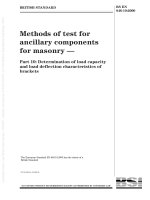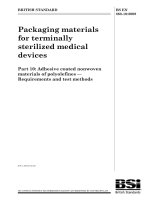Bsi bs en 61290 10 5 2014
Bạn đang xem bản rút gọn của tài liệu. Xem và tải ngay bản đầy đủ của tài liệu tại đây (1.3 MB, 26 trang )
BS EN 61290-10-5:2014
BSI Standards Publication
Optical amplifiers —
Test methods
Part 10-5: Multichannel parameters —
Distributed Raman amplifier gain and
noise figure
BRITISH STANDARD
BS EN 61290-10-5:2014
National foreword
This British Standard is the UK implementation of EN 61290-10-5:2014. It is
identical to IEC 61290-10-5:2014.
The UK participation in its preparation was entrusted by Technical
Committee GEL/86, Fibre optics, to Subcommittee GEL/86/3, Fibre optic
systems and active devices.
A list of organizations represented on this committee can be obtained on
request to its secretary.
This publication does not purport to include all the necessary provisions of
a contract. Users are responsible for its correct application.
© The British Standards Institution 2014.
Published by BSI Standards Limited 2014
ISBN 978 0 580 80341 3
ICS 33.180.30
Compliance with a British Standard cannot confer immunity from
legal obligations.
This British Standard was published under the authority of the
Standards Policy and Strategy Committee on 31 August 2014.
Amendments/corrigenda issued since publication
Date
Text affected
BS EN 61290-10-5:2014
EUROPEAN STANDARD
EN 61290-10-5
NORME EUROPÉENNE
EUROPÄISCHE NORM
July 2014
ICS 33.180.30
English Version
Optical amplifiers - Test methods - Part 10-5: Multichannel
parameters - Distributed Raman amplifier gain and noise figure
(IEC 61290-10-5:2014)
Amplificateurs optiques - Méthodes d'essai - Partie 10-5:
Paramètres à canaux multiples - Gain et facteur de bruit
des amplificateurs Raman répartis
(CEI 61290-10-5:2014)
Prüfverfahren für Lichtwellenleiter-Verstärker - Teil 10-5:
Mehrkanalparameter - Verstärkung und Rauschzahl von
verteilten Raman-Verstärkern
(IEC 61290-10-5:2014)
This European Standard was approved by CENELEC on 2014-06-27. CENELEC members are bound to comply with the CEN/CENELEC
Internal Regulations which stipulate the conditions for giving this European Standard the status of a national standard without any alteration.
Up-to-date lists and bibliographical references concerning such national standards may be obtained on application to the CEN-CENELEC
Management Centre or to any CENELEC member.
This European Standard exists in three official versions (English, French, German). A version in any other language made by translation
under the responsibility of a CENELEC member into its own language and notified to the CEN-CENELEC Management Centre has the
same status as the official versions.
CENELEC members are the national electrotechnical committees of Austria, Belgium, Bulgaria, Croatia, Cyprus, the Czech Republic,
Denmark, Estonia, Finland, Former Yugoslav Republic of Macedonia, France, Germany, Greece, Hungary, Iceland, Ireland, Italy, Latvia,
Lithuania, Luxembourg, Malta, the Netherlands, Norway, Poland, Portugal, Romania, Slovakia, Slovenia, Spain, Sweden, Switzerland,
Turkey and the United Kingdom.
European Committee for Electrotechnical Standardization
Comité Européen de Normalisation Electrotechnique
Europäisches Komitee für Elektrotechnische Normung
CEN-CENELEC Management Centre: Avenue Marnix 17, B-1000 Brussels
© 2014 CENELEC All rights of exploitation in any form and by any means reserved worldwide for CENELEC Members.
Ref. No. EN 61290-10-5:2014 E
BS EN 61290-10-5:2014
EN 61290-10-5:2014
-2-
Foreword
The text of document 86C/1142/CDV, future edition 1 of IEC 61290-10-5, prepared by SC 86C "Fibre
optic systems and active devices” of IEC/TC 86 “Fibre optics" was submitted to the IEC-CENELEC
parallel vote and approved by CENELEC as EN 61290-10-5:2014.
The following dates are fixed:
•
latest date by which the document has to be
implemented at national level by
publication of an identical national
standard or by endorsement
(dop)
2015-03-27
•
latest date by which the national
standards conflicting with the
document have to be withdrawn
(dow)
2017-06-27
Attention is drawn to the possibility that some of the elements of this document may be the subject of
patent rights. CENELEC [and/or CEN] shall not be held responsible for identifying any or all such
patent rights.
Endorsement notice
The text of the International Standard IEC 61290-10-5:2014 was approved by CENELEC as a
European Standard without any modification.
In the official version, for Bibliography, the following notes have to be added for the standards indicated:
IEC 61290-3
NOTE
Harmonized as EN 61290-3.
IEC 61290-10-4
NOTE
Harmonized as EN 61290-10-4.
BS EN 61290-10-5:2014
EN 61290-10-5:2014
-3-
Annex ZA
(normative)
Normative references to international publications
with their corresponding European publications
The following documents, in whole or in part, are normatively referenced in this document and are
indispensable for its application. For dated references, only the edition cited applies. For undated
references, the latest edition of the referenced document (including any amendments) applies.
NOTE 1 When an International Publication has been modified by common modifications, indicated by (mod), the relevant
EN/HD applies.
NOTE 2 Up-to-date information on the latest versions of the European Standards listed in this annex is available here:
www.cenelec.eu
Publication
Year
Title
EN/HD
Year
IEC 60825-1
-
EN 60825-1
-
IEC 61291-1
-
EN 61291-1
-
IEC 61291-4
-
EN 61291-4
-
IEC/TR 61292-4
-
Safety of laser products -- Part 1:
Equipment classification and requirements
Optical amplifiers -- Part 1: Generic
specification
Optical amplifiers -- Part 4: Multichannel
applications - Performance specification
template
Optical amplifiers -- Part 4: Maximum
permissible optical power for the damagefree and safe use of optical amplifiers,
including Raman amplifiers
-
-
–2–
BS EN 61290-10-5:2014
IEC 61290-10-5:2014 © IEC 2014
CONTENTS
1
Scope and object ............................................................................................................. 5
2
Normative references ...................................................................................................... 5
3
Terms, definitions and abbreviations ............................................................................... 6
3.1
Terms and definitions .............................................................................................. 6
3.2
Abbreviated terms ................................................................................................... 7
4
DRA gain and noise figure parameters – Overview .......................................................... 7
5
Apparatus ........................................................................................................................ 9
5.1
5.2
5.3
5.4
5.5
5.6
5.7
5.8
6
Test
7
General ................................................................................................................... 9
Multi-channel signal source ................................................................................... 10
Polarization controller ........................................................................................... 11
Optical spectrum analyser ..................................................................................... 11
Optical power meter .............................................................................................. 12
Tuneable narrowband source ................................................................................ 12
Broadband optical source ..................................................................................... 12
Optical connectors and jumpers ............................................................................ 12
sample ................................................................................................................... 12
Procedure ...................................................................................................................... 12
7.1
Overview............................................................................................................... 12
7.1.1
Channel on-off gain ....................................................................................... 12
7.1.2
Pump module channel insertion loss and channel net gain ............................ 13
7.1.3
Channel equivalent noise figure (NF) ............................................................. 13
7.2
Calibration ............................................................................................................ 13
7.2.1
Calibration of optical bandwidth ..................................................................... 13
7.2.2
Calibration of OSA power correction factor .................................................... 15
7.3
Measurement ........................................................................................................ 15
7.4
Calculation ............................................................................................................ 17
7.4.1
Channel on-off gain ....................................................................................... 17
7.4.2
Channel net gain ........................................................................................... 17
7.4.3
Channel equivalent NF................................................................................... 17
8
Test results ................................................................................................................... 17
Annex A (informative) Field measurements versus laboratory measurements ...................... 19
Annex B (informative) Pump depletion and channel-to-channel Raman scattering ................ 20
Bibliography .......................................................................................................................... 21
Figure 1 – Distributed Raman amplification in co-propagating (left) and countpropagating (right) configurations ........................................................................................... 9
Figure 2 – Measurement set-up without a pump module........................................................ 10
Figure 3 – Measurement set-up for counter-propagating configuration .................................. 10
Figure 4 – Measurement set-up for co-propagating configuration .......................................... 10
Figure 5 – Possible implementation of a multi-channel signal source .................................... 11
BS EN 61290-10-5:2014
IEC 61290-10-5:2014 © IEC 2014
–5–
OPTICAL AMPLIFIERS –
TEST METHODS –
Part 10-5: Multichannel parameters –
Distributed Raman amplifier gain and noise figure
1
Scope and object
This part of IEC 61290 applies to distributed Raman amplifiers (DRAs). DRAs are based on
the process whereby Raman pump power is introduced into the transmission fibre, leading to
signal amplification within the transmission fibre through stimulated Raman scattering.
A detailed overview of the technology and applications of DRAs can be found in
IEC TR 61292-6.
A fundamental difference between these amplifiers and discrete amplifiers, such as EDFAs, is
that the latter can be described using a black box approach with well-defined input and output
ports. On the other hand, a DRA is basically a pump module, with the actual amplification
process taking place along the transmission fibre. This difference means that standard
methods described in other parts of IEC 61290 for measuring amplifier parameters, such as
gain and noise figure, cannot be applied without modification.
The object of this standard is to establish uniform requirements for accurate and reliable
measurements, using an optical spectrum analyser (OSA), of the following DRA parameters:
a) channel on-off gain;
b) pump unit insertion loss;
c) channel net gain;
d) channel signal-spontaneous noise figure.
The measurement method is largely based on the interpolated source subtraction (ISS)
method using an optical spectrum analyser, as described and elaborated in IEC 61290-10-4,
with relevant modifications relating to a DRA.
All numerical values followed by (‡) are suggested values for which the measurement is
assured. Other values may be acceptable but should be verified.
NOTE
2
General aspects of noise figure test methods are reported in IEC 61290-3.
Normative references
The following documents, in whole or in part, are normatively referenced in this document and
are indispensable for its application. For dated references, only the edition cited applies. For
undated references, the latest edition of the referenced document (including any
amendments) applies.
IEC 60825-1, Safety of laser products – Part 1: Equipment classification and requirements
IEC 61291-1, Optical amplifiers – Part 1: Generic specification
IEC 61291-4, Optical
specification template
amplifiers
–
Part
4:
Multichannel
applications
–
Performance
–6–
BS EN 61290-10-5:2014
IEC 61290-10-5:2014 © IEC 2014
IEC TR 61292-4, Optical amplifiers – Part 4: Maximum permissible optical power for the
damage-free and safe use of optical amplifiers, including Raman amplifiers
3
3.1
Terms, definitions and abbreviations
Terms and definitions
3.1.1
Raman pump power
optical power produced by the DRA to enable Raman amplification of signal channels
Note 1 to entry:
The Raman pump power shall be at a lower wavelength than the signal channels.
3.1.2
fibre span
length of fibre into which signal channels and Raman pump power are introduced, and Raman
amplification of the signal channels takes place via stimulated Raman scattering
3.1.3
co-propagating configuration
forward pumping configuration
configuration whereby the Raman pump power is coupled to the input of the fibre span such
that the signal channels and Raman pump power propagate in the same (forward) direction
3.1.4
counter-propagating configuration
backward pumping configuration
configuration whereby the Raman pump power is coupled to the output of the fibre span such
that the signal channels and Raman pump power propagate in opposite directions
3.1.5
pump module
module that produces Raman pump power and couples it into the connected fibre span
Note 1 to entry: If the pump module is connected to the input of the fibre span, then both the incoming signal
channels and Raman pump power are coupled to the fibre span.
Note 2 to entry: If the pump module is connected to the output of the fibre span, then the pump power is coupled
into the fibre span, while the signal channels exiting the fibre span pass through the pump module from the input
port to the output port.
Note 3 to entry: In this standard, the convention will be used whereby the input port of the pump module is
defined as the port into which the signal channels enter, while the output port is defined as the port through which
the signal channels exit. Thus, in co-propagating configuration the Raman pump power exits the pump module from
the output port, while in counter-propagating configuration the Raman pump power exits the pump module from the
input port.
3.1.6
channel on-off gain
G on-off
ratio of the channel power at the output of the fibre span when the pump module is
operational to the channel power at the same point when the pump module is not operational
3.1.7
pump module channel insertion loss
IL
ratio of the channel power at the input of the pump module to the channel power at the output
of the pump module
BS EN 61290-10-5:2014
IEC 61290-10-5:2014 © IEC 2014
–7–
3.1.8
channel net gain
G net
channel on-off gain minus the pump module channel insertion loss, in dB
3.1.9
channel equivalent noise figure
NF sig-ASE,eq
channel noise figure due to signal-spontaneous beat noise (see IEC 61290-3) of an equivalent
discrete amplifier placed at the output of the fibre span which has the same channel gain as
the DRA channel on-off gain, and generates the same amount of ASE as that generated by
the DRA at the output of the fibre span.
3.2
Abbreviated terms
ASE
amplified spontaneous emission
DRA
distributed Raman amplifier
EDFA
Erbium doped fibre amplifier
FWHM
full-width half-maximum
GFF
gain flattening filter
ISS
interpolated source subtraction
NF
noise figure
RBW
resolution bandwidth
OSA
optical spectrum analyser
OSNR
optical signal-to-noise ratio
PCF
power correction factor
SMF
single-mode fibre
SSE
source spontaneous emission
VOA
variable optical attenuator
4
DRA gain and noise figure parameters – Overview
NOTE Unless specifically stated otherwise, all equation and definitions in this clause and onwards are given in
linear units, and not dB.
Figure 1 shows the application of DRAs in co-propagating (forward pumping) and counterpropagating (backward pumping) configurations. As a general rule, counter propagating
configuration is much more widely used compared to co-propagating configuration.
As with any amplifier, one of the main parameters of interest is the channel gain (see
IEC 61291-1 and IEC 61291-4). However, unlike discrete amplifiers, where the channel gain
is simply defined as the ratio of the channel power at the output port to the channel power at
the input port, with a DRA, the situation is more complex. In principle, the DRA includes both
the pump module, which supplies the pump power, and the fibre span, where the actual
amplification takes place. Thus, one option for defining channel gain is to define it as the ratio
of the channel power at point C (Figure 1) to the channel power at point A, while the pumps
are operational. However, since this definition also include the fibre span loss, which is often
larger than the gain supplied by the Raman pumps, this definition is not very useful.
A much more useful quantity is the channel on-off gain, which is defined as the ratio of the
channel power at the output of the fibre span when the Raman pumps are on to the channel
power at the same point but when the pumps are off (see the graphs in Figure 1).
–8–
Gon − off =
BS EN 61290-10-5:2014
IEC 61290-10-5:2014 © IEC 2014
Pon
Poff
(1)
In practice, the channel on-off gain may be measured at any point following the fibre span, for
example point C for co-propagating configuration, or points B and C for the counterpropagating configuration.
Another parameter of interest for DRAs is the pump module channel insertion loss, which is
defined as the ratio of the channel power at the input port of the pump module to the channel
power at the output port of the pump module (points A and B for co-propagating configuration,
and points B and C for counter propagating configuration).
IL =
Ppump unit input
Ppump unit output
(2)
Since no amplification takes place within the pump module, this is just passive insertion loss,
and is not affected by the status of the pumps (on or off).
The channel on-off gain and pump module channel insertion loss can be combined into a
single quantity, the channel net gain, which is defined in dB as
Gnet (dB ) = Gon − off (dB ) − IL(dB )
(3)
The channel net gain is particularly useful for counter-propagating configuration, as it may be
directly measured in linear units as the ratio of the channel power at point C when the pumps
are on to the channel power at point B when the pumps are off. When the pump module
includes a gain flattening filter (GFF) to tailor the spectral shape of the Raman gain, then the
channel net gain includes the effect of the GFF, as opposed to the channel on-off gain which
does not (i.e. the channel on-off gain has a non-flat dependence on the channel wavelength).
For the co-propagating configuration, the channel net gain has less physical meaning, and it
is more common to separately define the channel on-off gain and pump module channel
insertion loss.
Another important parameter relevant to a DRA is the channel equivalent noise figure (NF)
due to signal-spontaneous beat noise. This quantity is only relevant to counter-propagating
configuration. The channel equivalent NF of a DRA is defined as the NF of an equivalent
discrete amplifier placed at the output of the fibre span, which provides the same amount of
channel gain as the DRA channel on-off gain, and generates the same amount of amplified
spontaneous emission (ASE) as that generated at the fibre span output by the DRA. The
channel equivalent noise figure (in dB) due to signal-spontaneous beat noise is given by (see
IEC 61290-3):
NFsig − ASE,eq = 10 log10 (ρ ASE,B / (Gon − off hν ))
(4)
where
ρ ASE,B
is the ASE spectral density at the channel wavelength λ (in both polarization
modes) measured at the output of the fibre span (point B in the counter-propagating
configuration of Figure 1);
ν = c/λ
is the channel frequency;
h
is Planck’s constant.
Using the relation between the channel on-off gain and the channel net gain, it is easily
shown that the channel equivalent NF is also given by
BS EN 61290-10-5:2014
IEC 61290-10-5:2014 © IEC 2014
–9–
NFsig − ASE,eq = 10 log10 (ρ ASE,C / (Gnet hν ))
(5)
where
ρ ASE,C is now measured at point C.
Counter-propagating configuration
Co-propagating configuration
Fibre span
A
Pump
module
Signal
B
C
30
Power (dBm)
0
–10
–20
On-off
gain
NOTE
50
100
Position along span (km)
150
Pump
module
C
Pump
Signal with pump on
Signal with pump off
20
10
0
B
Pump
Pump
Signal with pump on
Signal with pump off
20
–30
Signal
A
Pump
30
Power (dBm)
Fibre span
10
0
–10
–20
–30
On-off
gain
0
50
100
Position along span (km)
150
IEC 1389/14
The graphs show the evolution of pump and signal along the fibre span.
Figure 1 – Distributed Raman amplification in co-propagating (left)
and count-propagating (right) configurations
When measuring DRA gain and NF, the following issues should be considered:
a) The purpose of the measurement: whether the purpose is to measure the DRA
performance in relation to a specific span of fibre in the field, or characterize DRA
performance with respect to a generic fibre type in the laboratory. This is elaborated in
Annex A.
b) Whether or not the input signal configuration can affect the measurement due to pump
depletion and/or signal-signal Raman scattering. This is elaborated in Annex B.
5
5.1
Apparatus
General
Figures 2 through 4 show the measurement set-up for measurement of DRA parameters in
counter-propagating and co-propagating configurations. The various components comprising
the set-up (as well as other components used for calibration) are described in the following
subclauses.
BS EN 61290-10-5:2014
IEC 61290-10-5:2014 © IEC 2014
– 10 –
Fibre span
Signal
Multi-channel
signal source
Polarization
controller
OSA
IEC 1390/14
Figure 2 – Measurement set-up without a pump module
Fibre span
Signal
Multi-channel
signal source
Pump
module
Polarization
controller
OSA
Pump
IEC 1391/14
Figure 3 – Measurement set-up for counter-propagating configuration
Fibre span
Signal
Multi-channel
signal source
Polarization
controller
Pump
module
OSA
Pump
IEC 1392/14
Figure 4 – Measurement set-up for co-propagating configuration
5.2
Multi-channel signal source
Figure 5 shows a possible implementation of a multi-channel signal source. This optical
source should consist of n laser sources where n is the number of channels for the test
configuration. The full width at half maximum (FWHM) of the output spectrum of each laser
source shall be narrower than 0,1 nm (‡) 1 so as not to cause any interference to adjacent
channels. The suppression ratio of the side modes of the single-line laser shall be higher than
35 dB (‡). The output power fluctuation shall be less than 0,05 dB (‡), which is more easily
attainable with an optical isolator placed at the output port of each source. The wavelength
———————
1
Suggested value.
BS EN 61290-10-5:2014
IEC 61290-10-5:2014 © IEC 2014
– 11 –
accuracy shall be better than ±0,1 nm (‡) with stability better than ±0,01 nm (‡). The
spontaneous emission power within a 1 nm window surrounding the laser wavelength should
be at least 40 dB below the laser output power.
The purpose of the channel combiner is to multiplex all the laser sources onto a single fibre.
The channel combiner should have polarization dependent loss better than 0,5 dB (‡), and
wavelength dependent loss better than 1 dB (‡).The reflectance from this device shall be
smaller than –50 dB (‡) at each port.
Channel combiner
λ1
Laser
source
Variable
optical
attenuator
λn
IEC 1393/14
Figure 5 – Possible implementation of a multi-channel signal source
The multi-channel signal source should provide the ability to control the power of each
individual laser, so as to achieve a desired power configuration of the channels. This can be
achieved either through direct control of each laser source, or by placing a variable optical
attenuator (VOA) after each laser source. The multi-channel signal source should preferably
also provide the ability to control the power of all the sources simultaneously, e.g. using a
variable optical attenuator (VOA) as shown in Figure 5. If one or more VOA is used, then its
attenuation range and stability shall be over 40 dB (‡) and better than 0,1 dB (‡), respectively.
The reflectance from this device shall be smaller than –50 dB (‡) at each port. If a VOA is
placed after the channel combiner, the wavelength flatness over the full range of attenuation
shall be less than 0,5 dB (‡).
5.3
Polarization controller
This device shall be able to convert any state of polarization of a signal to any other state of
polarization. The polarization controller may consist of an all-fibre polarization controller or a
quarter-wave plate rotatable by a minimum of 90°, followed by a half-wave plate rotatable by a
minimum of 180°. The reflectance of this device shall be smaller than –50 dB (‡) at each port.
The insertion loss variation of this device shall be less than 0,5 dB (‡). The use of a
polarization controller is considered optional, but may be necessary to achieve the desired
accuracy for cases when the DRA exhibits significant polarization dependent gain.
5.4
Optical spectrum analyser
The optical spectrum analyser (OSA) shall have polarization sensitivity less than 0,1 dB (‡),
stability better than 0,1 dB (‡) and wavelength accuracy better than 0,05 nm (‡). The linearity
should be better than 0,2 dB (‡) over the device dynamic range. The reflectance from this
device shall be smaller than –50 dB (‡) at its input port. The OSA shall have sufficient
dynamic range and support sufficiently small resolution bandwidth (RBW) to measure the
noise between channels. For 100 GHz (0,8 nm) channel spacing, the dynamic range shall be
greater than 55 dB at 50 GHz (0,4 nm) from the signal.
– 12 –
5.5
BS EN 61290-10-5:2014
IEC 61290-10-5:2014 © IEC 2014
Optical power meter
This device, which may be required for the calibration of the OSA, shall have a measurement
accuracy better than 0,2 dB (‡), irrespective of the state of polarization, within the operational
wavelength bandwidth of the DRA and within the power range from –40 dBm to +20 dBm (‡).
5.6
Tuneable narrowband source
This device, which may be required for the calibration of the OSA, shall be tuneable over the
operational wavelength bandwidth of the DRA (for example, 1 530 nm to 1 565 nm). The full
width at half maximum (FWHM) of the output spectrum of the narrowband source shall be
narrower than 0,1 nm (‡).The wavelength accuracy shall be better than ±0,1 nm (‡) with
stability better than ±0,01 nm (‡). The output power fluctuation shall be less than 0,1 dB (‡).
The output power shall remain stable to within 0,1 dB (‡) while tuning the wavelength over the
measurement bandwidth range (typically 10 nm).
5.7
Broadband optical source
This device, which may be required for the calibration of the OSA, shall provide broadband
optical power over the operational wavelength bandwidth of the DRA (for example, 1 530 nm
to 1 565 nm). The output spectrum shall be flat with less than a 0,1 dB (‡) variation over the
measurement bandwidth range (typically 10 nm). The output power fluctuation shall be less
than 0,1 dB (‡).
For example, the ASE generated by an optical fibre amplifier with no input signal applied
could be used as a broadband optical source.
5.8
Optical connectors and jumpers
Optical connectors and jumpers, which may be used to connect the various components in
Figures 2 through 4, should have a connection loss repeatability better than 0,1 dB (‡).
Preferably, the reflectance from optical connectors when used shall be smaller than –50 dB
(‡). Preferably, jumper length shall be short (<2 m), and jumpers shall remain undisturbed
during the duration of the measurement in order to minimize state of polarization change.
6
Test sample
The DRA under test, which consists of both the pump module and the fibre span, shall
operate at nominal operating conditions. Care shall be taken in maintaining the state of
polarization of the input light during the measurement. Changes in the polarization state of the
input light may result in input optical power changes because of the slight polarization
dependency expected from all the used optical components, leading to measurement errors
Due to high Raman pump power typically used in the measurement, laser safety procedures
should be implemented and followed as described in IEC 60825-1. In addition, extra care
should be taken with respect to connector cleanliness and avoidance of fibre bends, as
described in IEC TR 61292-4.
Connection loss between the pump module and fibre span should be minimized as much as
possible (preferably <0,2 dB) in order not to affect the measurement results.
7
Procedure
7.1
7.1.1
Overview
Channel on-off gain
For measuring the channel on-off gain, the following parameters shall be measured:
BS EN 61290-10-5:2014
IEC 61290-10-5:2014 © IEC 2014
– 13 –
a) The signal power level for each channel when the pump module is off (i.e. not emitting
Raman pump power), using the set-up shown in Figure 3 for counter-propagating
configuration, or the set-up shown in Figure 4 for co-propagating configuration.
b) The signal power level for each channel when the pump module is on (i.e. emitting Raman
pump power), using the set-up shown in Figure 3 for counter-propagating configuration, or
the set-up shown in Figure 4 for co-propagating configuration.
7.1.2
Pump module channel insertion loss and channel net gain
For measuring the pump module channel insertion loss and the channel net gain, the
following parameters shall be measured:
a) The signal power level for each channel according to the set-up shown in Figure 2.
b) The signal power level for each channel when the pump sources within the pump module
are off (i.e. not emitting Raman pump power), using the set-up shown in Figure 3 for
counter-propagating configuration, or the set-up shown in Figure 4 for co-propagating
configuration.
c) The signal power level for each channel when the pump sources within the pump module
are on (i.e. emitting Raman pump power), using the set-up shown in Figure 3 for counterpropagating configuration, or the set-up shown in Figure 4 for co-propagating
configuration
7.1.3
Channel equivalent noise figure (NF)
For measuring the channel equivalent NF for counter-propagating configuration, the following
parameters should be measured:
a) The signal power level for each channel using the set-up shown in Figure 2.
b) The source spontaneous emission (SSE) spectral power density at the wavelength of each
channel using the set-up shown in Figure 2.
c) The signal power level for each channel when the pump module is on (i.e. emitting Raman
pump power) using the set-up shown in Figure 3.
d) The ASE spectral power density at the wavelength of each channel when the pump
sources within the pump module are on (i.e. emitting Raman pump power) using the setup shown in Figure 3.
The noise-equivalent bandwidth of the OSA is required for the measurement of SSE and ASE
spectral power density. If not specified by the manufacturer to sufficient accuracy, it may be
calibrated using one of the two methods below. The noise-equivalent bandwidth of a
wavelength filter is the bandwidth of a theoretical filter with rectangular pass-band and the
same transmission at the centre wavelength that would pass the same total noise power as
the actual filter when the source power density is constant versus wavelength.
7.2
Calibration
7.2.1
7.2.1.1
Calibration of optical bandwidth
General
The noise-equivalent bandwidth, B o , can be calibrated using one of the following two
methods, based on the use of either a tuneable narrowband optical source or a broadband
optical source.
For both methods, the following approximate equation permits converting the optical
bandwidth from the wavelength domain, ∆ λ BW ( λ s ), to the frequency domain, B o ( λ s ):
[
Bo (λ S ) = c (λ s − ∆λBW (λ s ) / 2)−1 − (λ s + ∆λBW (λ s ) / 2)−1
]
(6)
BS EN 61290-10-5:2014
IEC 61290-10-5:2014 © IEC 2014
– 14 –
where c is the speed of light in free space.
Once the noise-equivalent bandwidth has been determined as above, the OSA resolution
bandwidth should remain unchanged throughout the measurement procedure.
The OSA resolution bandwidth shall be chosen such that it is narrow enough to accurately
measure ASE between any two channels of the multi-channel signal source with sufficiently
large dynamic range dynamic range.
7.2.1.2
Calibration using a tuneable narrowband optical source
The steps listed below shall be followed:
a) Connect the output of a tuneable narrowband optical source directly to the OSA.
b) Set the OSA centre wavelength to the signal wavelength to be calibrated, λ s .
c) Set the OSA span to zero (fixed wavelength).
d) Set the OSA resolution bandwidth to the desired value, RBW.
e) Set the narrowband optical source wavelength to λ i , within the range from λ S − RBW − δ
to λ S + RBW + δ , choosing δ large enough to ensure that the end wavelengths fall outside
the OSA filter pass-band.
Record the OSA signal level, P( λ i ), in linear units.
g) Repeat steps e) and f), incrementing the narrowband optical source wavelength through
the wavelength range by the tuning interval, ∆ λ , selected according to the accuracy
requirements as described below.
f)
h) Determine the optical bandwidth according to the following equation:
∆λBW (λ S ) =
P(λ
)
∑ P(λSi ) ∆λ
(7)
i
The procedure may be repeated for different signal wavelengths, or for each wavelength of
the multichannel source.
The accuracy of this measurement is related to the tuning interval of the narrowband optical
source (∆ λ ) and power flatness over the wavelength range. A tuning interval smaller than
0,1 nm is advisable. The optical power should not vary more than 0,4 dB over the wavelength
range.
7.2.1.3
Calibration using a broadband optical source
This method requires that the OSA have a rectangular shape bandwidth-limiting filter, when
the resolution bandwidth is at the maximum value. The steps listed below shall be followed:
a) Connect the output of a narrowband optical source directly to the OSA. If adjustable, as in
the case of a tuneable laser, set the wavelength of the source to a specific wavelength,
λs.
b) Set the OSA resolution bandwidth to the maximum value, preferably not larger than
10 nm.
c) Using the OSA, measure the FWHM of the OSA bandwidth by scanning over the
narrowband signal, ∆ λ RBWmax.
d) Connect the output of a broadband optical source directly to the OSA.
e) Keep the OSA resolution bandwidth at the maximum value.
f)
Using the OSA, measure the output power level, P RBWmax (in linear units), at the given
wavelength, λ s .
BS EN 61290-10-5:2014
IEC 61290-10-5:2014 © IEC 2014
– 15 –
g) Set the OSA resolution bandwidth to the desired value.
h) Using the OSA, measure the output power level, P RBW (in linear units), at the given
wavelength, λ s .
i)
Determine the optical bandwidth according to the following equation:
∆λBW (λS ) =
j)
PRBW
∆λRBWmax (λS )
PRBWmax
(8)
The procedure may be repeated for different signal wavelengths, or for each wavelength
of the multichannel signal source.
NOTE
7.2.2
It is assumed that the measurement at the maximum resolution bandwidth, ∆ λ RBW max, is accurate.
Calibration of OSA power correction factor
Follow the steps listed below to calibrate the OSA power correction factor (PCF). The power
correction factor calibrates the OSA for absolute power.
a) Adjust the multi-channel signal source to output a single channel at signal wavelength, λ s .
Connect the output of the multi-channel signal source directly to the input of the optical
power meter, and measure P PM (in dBm). Alternatively, the set-up in Figure 2 may be
used, with the OSA replaced by the optical power meter.
b) Disconnect the optical power meter, connect the OSA instead, and measure P OSA
(in dBm).
c) Determine the power calibration factor, PCF in dB, according to the following equation:
PCF (λ s ) = PPM − POSA
(9)
For the multi-channel signal source, turn λ 1 on and all other lasers off. Follow steps (a)
through (c) above. Then turn λ 2 on and all other lasers off. Repeat until a power calibration
factor is obtained for all n wavelengths.
7.3
Measurement
The measurement procedure for all parameters (channel on-off gain, channel net gain,
channel equivalent NF) is described in the following steps. If the channel equivalent NF is not
required, then steps b), c) and d) may be omitted (if the OSNR is high enough, see NOTE 1
below, then steps j) and k) may also be omitted). If only channel on-off gain is required, then
only steps f) through k) need be performed.
a) Connect the measurement set-up as shown in Figure 2.
b) Set the resolution bandwidth of the OSA to the calibrated value. Do not change this
setting throughout this procedure.
c) Adjust the relative power levels of each laser of the multichannel source, as well as the
absolute power level of all lasers using the VOA, according to the detailed specification.
Typically, the lasers shall be set to have equal power output.
d) Measure the source spontaneous emission power level at wavelengths offset to both sides
of each signal wavelength. The wavelength offset should be set to one-half the channel
spacing or less. Use linear interpolation to determine the noise power level,
OSA
(λ s ) in dBm, at each signal wavelength. Determine the calibrated source-spontaneous
PSSE
emission power level, PSSE (λ s ) in dBm, for each wavelength, according to the following
equation:
OSA
(λs ) + PCF
PSSE (λs ) = PSSE
(10)
BS EN 61290-10-5:2014
IEC 61290-10-5:2014 © IEC 2014
– 16 –
e) Measure the power level of each signal, PINOSA (λ s ) in dBm. Determine the calibrated power
level of each input signal wavelength using the following equation:
Pin (λs ) = PinOSA (λs ) + PCF
f)
(11)
For counter-propagating configuration, add the pump module to the measurement set-up
as shown in Figure 3. For the co-propagating configuration, use Figure 4. Make sure the
pumps sources within the pump module are off (i.e. not emitting Raman pump power).
g) Measure the power level of each signal, PoffOSA (λs ) in dBm. Determine the calibrated power
level of each input signal wavelength using the following equation:
Poff (λs ) = PoffOSA (λs ) + PCF
(12)
h) Switch on and set the pump sources within the pump module to the desired pump
configuration (pump power for each pump wavelength), according to the detailed
specifications.
i)
OSA
(λs ) in dBm. Determine the calibrated power
Measure the power level of each signal, Pon
level of each input signal wavelength using the following equation:
Pon (λs ) = PonOSA (λs ) + PCF
j)
(13)
Measure the uncorrected forward ASE power level at wavelengths offset to both sides of
each signal wavelength. The wavelength offset should be set to one-half the channel
OSA
(λ s )
spacing or less. Use linear interpolation to determine the noise power level, PASE
in dBm, at each signal wavelength. Determine the calibrated total forward ASE power
level, PASE (λ s ) in dBm, for each channel wavelength, according to the following equation:
OSA
(λs ) + PCF
PASE (λs ) = PASE
(14)
k) Determine the corrected signal output power in dBm at each channel by subtracting the
noise power using the following equation:
sig
Pon
NOTE 1
PASE (λs )
Pon (λs )
(λs ) = 10 log10 10 − 10 10
If the OSNR is high enough, then this means that
sig
( )
(15)
PASE (λs ) << Pon (λs ) , so that step k) is not necessary.
( )
Thus, with good accuracy we may write Pon λs ≅ Pon λs . In general, If the ONSR >20 dB, then the ASE
correction factor to the signal power is <0,1 dB, and this simplification may be used.
NOTE 2 If a field measurement is being performed in co-propagating configuration, then the above procedure
requires access to both ends of the fibre span, which may be located at far distances one from the other. In this
case, it may only be practical to carry out steps f) through k), which yields the on-off gain, assuming the pump
module can be controlled remotely. If the channel net gain is also required, then the pump module channel
insertion loss may be measured separately.
If it is required to measure polarization dependent channel on-off gain, then steps f) through i)
should be repeated for different settings of the polarization controller. Following this, step j)
can be performed once, and then step k) can be applied to all results obtained in step i) for
different settings of the polarization controller. Finally, the channel on-off gain for different
setting of the polarization controller can be calculated as in Equation (16). The polarization
dependent gain is then given as the difference in dB between the maximum measured value
and the minimum measured value of the channel on-off gain.
BS EN 61290-10-5:2014
IEC 61290-10-5:2014 © IEC 2014
7.4
– 17 –
Calculation
7.4.1
Channel on-off gain
The channel on-off gain, Gon − off (λs ) in dB, may be calculated as
sig
(λs ) − Poff (λs )
Gon − off (λs ) = Pon
7.4.2
(16)
Channel net gain
The pump module channel insertion loss, IL(λs ) in dB, may be calculated as
IL(λs ) = Pin (λs ) − Poff (λs )
(17)
The channel net gain, Gnet (λs ) in dB, may be calculated as
Gnet (λs ) = Gon − off (λs ) − IL(λs )
7.4.3
(18)
Channel equivalent NF
Determine the DRA contribution to the total forward ASE power level at each signal
DRA
(λs ) in dBm, by subtracting the source-spontaneous emission power level,
wavelength, PASE
which is increased by the channel net gain of the DRA, from the calibrated total ASE power
level, according to the following equation:
DRA
ASE
P
Gnet (λ )+ PSSE (λ )
PASE (λ )
10
(λ ) = 10 log10 10 − 10
(19)
The channel equivalent NF, NFsig − ASE,eq (λs ) in dB, may be calculated as
DRA
(λs ) − Gnet (λs ) − 10 log[hνBo (λs )]
NFsig − ASE,eq (λs ) = PASE
(20)
where
the noise equivalent bandwidth Bo (λs ) is given in frequency units (see Equation (5));
h
is Planck’s constant;
ν
is the optical signal frequency.
NOTE The accuracy of this test method is very dependent on the repeatability of the insertion loss due optical
connections when they are broken and remade, as well as on the polarization dependence of the OSA.
8
Test results
The following parameters should be presented:
a) Arrangement of test set-up (if different from the one specified in Clause 4).
b) Measurement technique; here: multichannel interpolation source subtraction.
c) Type of multi-channel signal source used.
BS EN 61290-10-5:2014
IEC 61290-10-5:2014 © IEC 2014
– 18 –
d) Configuration
distribution).
of
multi-channel
signal
source
(channel
wavelengths
and
power
e) OSA noise equivalent bandwidth, Bo , assuming this parameter does not have significant
wavelength dependence. If this is not the case, then it should be presented separately for
each channel wavelength.
f)
Ambient temperature (if requested).
g) Pump source configuration (wavelengths and powers of each Raman pump laser) of the
pump module.
h) Total power of all signal channels at the output of the fibre span when the pump module is
disconnected (Figure 2).
i)
j)
The set of channel wavelengths at which the measurement was performed.
For each channel, the channel on-off gain, Gon − off (λs ) in dB.
k) For each channel, the pump unit channel insertion loss IL(λs ) in dB.
l)
For each channel, the channel net gain, Gnet (λs ) in dB.
DRA
(λs ) in dBm.
m) For each channel, the total forward ASE power level, PASE
n) For each channel, the channel signal-spontaneous noise figure, NFsig − ASE,eq (λs ) in dB
NOTE
An error estimate for
NFsig − ASE,eq (λs ) due to subtraction of SSE may also be provided with the results,
if this error is larger than 0,1 dB (‡). For details on how to estimate the error, refer to IEC 61290-10-4.
BS EN 61290-10-5:2014
IEC 61290-10-5:2014 © IEC 2014
– 19 –
Annex A
(informative)
Field measurements versus laboratory measurements
Since the performance of a DRA specifically depends on the fibre span with which it is
measured, it is useful to differentiate between two types of measurements:
a) Field measurement – The purpose of this measurement is to assess the DRA performance
with the specific fibre span deployed in the field. Thus, the measurement is only
applicable and relevant to this particular fibre span, characterized by the specific sections
of fibre comprising the span, and by any discrete loss points located along the span.
b) Laboratory measurement – The purpose of this type of measurement is usually to
characterize the DRA performance with respect a specific type of fibre, such as standard
single mode fibre (SMF). Thus, the fibre span used in the measurement should represent
as best as possible a generic fibre span of that type. Preferably, the fibre span should be
long enough so that the Raman on-off gain does not depend on the length. For a typical
DRA with up to 1 W pump power in the 1 400 nm to 1 500 nm wavelength range, a length
of >75 km is sufficient to emulate an infinite length of fibre. Additionally, there should be
no significant discrete loss points located along the fibre span, and in particular, the
connection loss between the fibre span and the pump module should be as low as
possible (preferably <0,2 dB).
– 20 –
BS EN 61290-10-5:2014
IEC 61290-10-5:2014 © IEC 2014
Annex B
(informative)
Pump depletion and channel-to-channel Raman scattering
In many counter-propagating DRA application, the DRA operates in the small signal regime,
where the channel on-off gain does not depend on the power or wavelength of the other
channels. In measurements relevant to such applications, care should be taken to launch
sufficiently weak channel power into the fibre span, so as to emulate small signal conditions,
However, in other cases the channel on-off gain may depend on the configuration of the other
optical channels (power and/or wavelength) transmitted in the fibre span. In this case, it is
important to select the channel configuration relevant to the required application of the DRA,
and record the channel configuration as part of the measurement conditions.
The channel configuration may be important in two cases:
a) Pump depletion – this refers to the situation where the total optical power due to all
channels at the input to the fibre span is high enough to affect the channel on-off gain. In
many applications of counter-propagating DRA, this situation does not occur, since the
Raman scattering takes place at the end of the fibre span after the channels have been
significantly attenuated. However, it may be relevant to applications involving relatively
short fibre spans (<80 km), and/or a large number of channels. On the other hand, pump
depletion is almost always relevant to co-propagating DRA applications, since in this case
the Raman scattering occurs at the beginning of the fibre span where the channel power
is strong.
b) Channel-to-channel Raman interaction – This refers to the transfer of power from lower
wavelength channels to higher wavelength channels due to stimulated Raman scattering.
This effect occurs only for high enough channel power, and is typically only relevant to copropagating DRA. This is due to the fact that the channel powers are already high at the
input to the fibre span, and are further amplified by the DRA. Thus, the channel powers
along the span may reach a level sufficient to cause significant channel-to-channel Raman
interaction. In this case, the Raman on-off gain not only includes the direct effect of the
pump power, but also the secondary effect of the channel-channel interaction. Thus, the
channel on-off gain depends on both the power and wavelength configuration of all the
channels.
BS EN 61290-10-5:2014
IEC 61290-10-5:2014 © IEC 2014
– 21 –
Bibliography
IEC 61290-3, Optical amplifiers – Test methods – Part 3: Noise figure parameters
IEC 61290-10-4, Optical amplifiers – Test methods – Part 10-4: Multichannel parameters –
Interpolated source subtraction method using an optical spectrum analyzer
IEC TR 61292-6, Optical amplifiers – Part 6: Distributed Raman amplification
_____________
This page deliberately left blank
This page deliberately left blank









